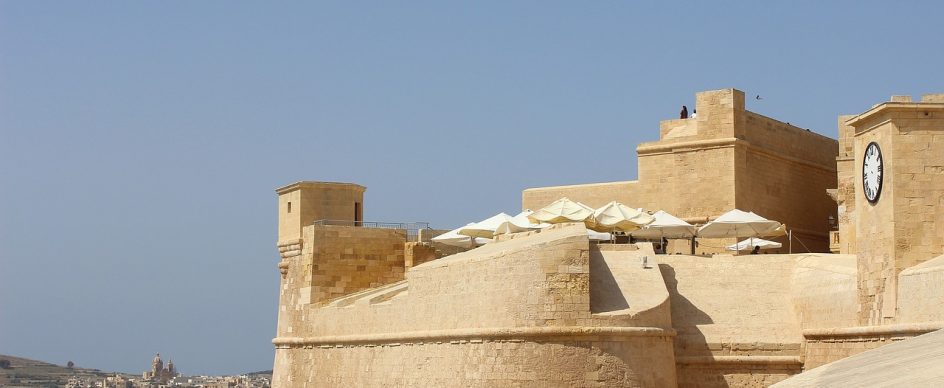
Fortified Cities in Malta
- Mar 2, 2019
Within the fortified walls, time appears to stand still but look closer...
The small sunshine isles of Malta and Gozo pack a massive historical punch. Their geographical location has ensured their importance in military history for centuries. From the Byzantines to the British; each of Malta’s rulers have left their defences to tell the tale of Malta’s history. Some of the most striking of these are the fortified cities. Within the fortified walls, time appears to stand still but look closer, and they are living cities with a past, present and a future.
Cittadella: Gozo
The Cittadella found on the island of Gozo, was originally an Acropolis dating back to the Bronze Age. It’s life as a fortification started during Medieval times and was further developed by the Knights of St. John in the 16th century. The fortifications were used to keep all Gozo treasures safe from marauding pirates and corsairs, as well as all the islands people at night. Much of the city despite the ravages of time is well-preserved, as restoration work has recently taken place. Outside of the Cittadella walls you can visit the city of Rabat, the busy capital of Gozo. The Cittadella is a small and compact city however there is much for a tourist to enjoy. There are several museums to visit, along with the opportunity to take Instagram photos from the bastions, with a backdrop of beautiful Gozo island.
Valletta: Mainland
UNESCO say that Valletta is “one of the most concentrated historic areas in the world”. The city that was envisaged by the Grand Master de Vallette was built after the Great Siege of 1565, when Malta was besieged by a vast Ottoman fleet of some 40,000 men. Valletta however was created not only to be a fortress city, but also as a cultural home to some of the finest architecture and works of art from the 16th century. This vision was underlined by Valletta becoming the European Capital of Culture during 2018. Valletta’s history is tied to every ruler that was to follow the Knights of St. John but the most significant footnote in its time line after its baroque origins, is British rule and the important role it played in defeating Nazi forces during World War II. Vibrant Valletta is a true historic gem to be cherished and enjoyed. The mix of architecture, art and culture is truly unique. Add to this the natural beauty of its geography, sitting upon a peninsula betwixt two stunning natural harbours, it really is one not to be missed.
The Three Cities
The Three Cities are made up of Vittoriosa, Cospicua and Senglea, or Birgu, Bormla and Isla in Maltese, respectively. The oldest of them is Birgu, whose beginnings date back to the Middle Ages. The Knights of St. John saw the importance in this natural harbour’s position as their headquarters back in the 16th century, so at this stage works began on Vittoriosa’s fortifications.
Senglea and Cospicua were also founded by the Knights in the 16th and 17th centuries. The Three Cities retain strong links to Malta’s history and the authentic local atmosphere, as they remain relatively unspoilt by modern day tourism. In Vittoriosa you will find beautiful old houses, Auberges, and the Inquisitor’s Palace built by the Knights. The Birgu Waterfront is a very modern venue to see and be seen, especially if dining al fresco whilst sipping a fine Maltese wine besides the yachts moored in the marina, is something you’re looking forward to! A wander around the Three Cities will show you all the different facets of life in Malta.
Mdina: The Silent City
Mdina also known as The Silent City began its life in the 8th Century BC. Under the Romans it was the city of Melite, and then it was finally reduced to present-day Mdina by the Byzantines. For centuries Mdina was the capital of Malta and home to Maltese nobility, as well as the centre of religious life. The rule of Knights of St. John changed the direction of Mdina as they recognised the need to access the Grand Harbour in Birgu (Vittoriosa) for the defence of the island and for growing international commerce. Then following the Great Siege, the city of Valletta was founded, and Malta’s modern capital was born. Mdina today with a population of just 300 wears its Medieval heart on its sleeve, and the quaint mix of Norman and Baroque architecture is enthralling. Despite its size there is plenty to lose yourself in during your visit within the city walls -from the macabre Dungeons Torture Museum to the palatial noble home of Palazzo Falson. The views from the bastion and the entrenchment are Instagram worthy and St. Paul’s Co Cathedral and its museum are a must-see.
Where to stay whilst visiting Malta?
The fortified cities of Malta and Gozo are a real delight for any tourist, whether they have an eye for history or not. They are truly intriguing and the character that lives within them will be enough to charm you during your stay. Valletta is the perfect base for your visit and when in Valletta the boutique hotel ‘Casa Ellul’ is worth considering.
As the former family home of the Ellul family it provides luxury with a natural charisma that is unrivalled. Sitting in the heart of historic Valletta under the watchful eye of the Lady of Mount Carmel Church, on Old Theatre Street, you will spend your stay right within Malta’s past, whilst at the same time experience a luxurious feel in one of the stunning suites at Casa Ellul. We look forward to welcoming you to sample the magic of Malta’s history within its many a city wall.




